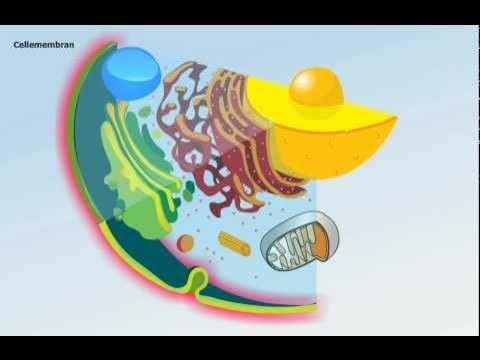THE MITOCHONDRIA | Cell organelles made EASY
Summary
TLDRIn this video, Miss Angler explains the structure and function of mitochondria, known as the Powerhouse of the cell. She covers key features such as the two membranes, cristae folds, and the matrix, which are crucial for energy production. The process of cellular respiration, which generates ATP using glucose and oxygen, is also explored. Miss Angler emphasizes the importance of understanding mitochondrial DNA and its maternal inheritance. She also provides tips on identifying mitochondria in micrographs and highlights their role in energy-hungry tissues like muscles. The video encourages students to use precise terminology, especially 'cellular respiration.'
Takeaways
- 😀 Mitochondria are known as the 'Powerhouse of the cell' because they generate energy through cellular respiration.
- 😀 Mitochondria have two membranes: an outer membrane and an inner membrane, with the inner one being folded to create cristae.
- 😀 The folds (cristae) in the inner membrane increase surface area, which helps facilitate more energy-producing chemical reactions.
- 😀 Inside the mitochondria is a fluid called the matrix, which contains the raw materials needed for cellular respiration.
- 😀 Mitochondria have their own ribosomes and DNA, which is passed down maternally, making them unique in the cell.
- 😀 Mitochondria cannot be created from scratch; they must be inherited and then replicate within the cell.
- 😀 Cellular respiration inside the mitochondria involves combining glucose and oxygen to produce ATP, carbon dioxide, and water vapor.
- 😀 ATP is the energy currency of the cell, which powers various cellular functions.
- 😀 Micrographs of mitochondria may look different from textbook illustrations; look for cristae and the characteristic shape (rod-like or oval).
- 😀 Tissues with high energy demands, such as muscle tissue, contain a large number of mitochondria.
- 😀 It’s important to use the term 'cellular respiration' rather than simply calling mitochondria the 'Powerhouse of the cell' in higher grades (grade 10 and above).
Q & A
What is the primary function of the mitochondria?
-The primary function of mitochondria is to produce energy for the cell by performing cellular respiration, converting glucose and oxygen into ATP, which the cell uses for its activities.
Why do mitochondria have two membranes?
-Mitochondria have two membranes—an outer membrane and an inner membrane—to increase surface area, which allows more chemical reactions to take place. The inner membrane is folded, further increasing the surface area for these reactions.
What are the folds in the inner membrane of the mitochondria called?
-The folds in the inner membrane of the mitochondria are called cristae (or crista in singular), and they help to increase the surface area to support more chemical reactions.
What is the matrix in the mitochondria?
-The matrix is the fluid-filled space inside the mitochondria where essential chemicals for cellular respiration are found. It also serves as the location for some of the chemical reactions involved in the process.
What special features do mitochondria have that distinguish them from other organelles?
-Mitochondria have their own ribosomes and DNA, which is inherited maternally (from the mother). This makes mitochondria unique among other organelles that rely on the cell's nuclear DNA.
How is mitochondrial DNA inherited?
-Mitochondrial DNA is inherited exclusively from the mother, as it is passed down through the egg cell. This is why mitochondrial DNA is used in tracing maternal ancestry.
How does the structure of the mitochondria aid in its function?
-The structure of mitochondria, including their two membranes and cristae, increases the surface area for chemical reactions. This allows for efficient production of ATP, the cell’s energy currency, during cellular respiration.
What are the main products of cellular respiration in the mitochondria?
-The main products of cellular respiration are ATP (energy), carbon dioxide (CO2), and water vapor (H2O). Glucose and oxygen are the reactants that drive the process.
Why do muscle cells contain a large number of mitochondria?
-Muscle cells contain many mitochondria because they require a lot of energy to perform their functions, such as contraction. Mitochondria produce the ATP needed for these high-energy demands.
What key visual features can help identify mitochondria in a micrograph?
-Mitochondria can be identified in a micrograph by their distinct folded inner membranes (cristae), their rod-like or circular shape, and the presence of these folds inside the mitochondria.
Outlines

Esta sección está disponible solo para usuarios con suscripción. Por favor, mejora tu plan para acceder a esta parte.
Mejorar ahoraMindmap

Esta sección está disponible solo para usuarios con suscripción. Por favor, mejora tu plan para acceder a esta parte.
Mejorar ahoraKeywords

Esta sección está disponible solo para usuarios con suscripción. Por favor, mejora tu plan para acceder a esta parte.
Mejorar ahoraHighlights

Esta sección está disponible solo para usuarios con suscripción. Por favor, mejora tu plan para acceder a esta parte.
Mejorar ahoraTranscripts

Esta sección está disponible solo para usuarios con suscripción. Por favor, mejora tu plan para acceder a esta parte.
Mejorar ahora5.0 / 5 (0 votes)






